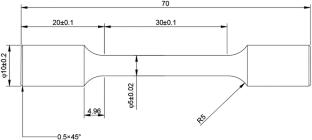Effect of Ultrasonic Vibration Treatment on Microstructure and Properties of Semi-Solid SnSbCu11-6 Alloy
Abstract
SnSbCu11-6 alloy is a commercial material for plain bearings, and the size and distribution of phases in the microstructure determine the properties and application of the material. In this paper, SnSbCu11-6 alloy semi-solid slurry was prepared by ultrasonic vibration treatment (UVT) process. The effects of UVT termination temperature on microstructure size, distribution and properties were studied. The results show that UVT can significantly refine the SnSb phase and Cu6Sn5 phase and improve the distribution uniformity. The SnSb phase are tightly bound to the matrix α-Sn phase and exist semi-coherent interface matching in (111)SnSb//(200)α−Sn. On the contrary, the Cu6Sn5/α-Sn interface is clear and well-bonded but no orientation relationship exists. The average grain size of SnSb phase and the average length of Cu6Sn5 phase decreased first and then increased with the decrease of the termination temperature of UVT. The optimal termination temperature of the UVT is 260 ℃ near the precipitation temperature of SnSb phase, at which the average grain size of SnSb phase is 48.8 ± 8.8 μm and the average length of Cu6Sn5 phase is 10 ± 4.2 μm. The tensile strength and elongation are 70.3 MPa and 3.6%, respectively, which are 6.0% and 140% higher than that of liquid casting. It is likely attributed to the fine grain strengthening with the semi-coherent interface SnSb phase and microstructure homogenization. Moreover, the fracture mechanism indicates that the fine SnSb phase can effectively prevent crack propagation and significantly improve the plasticity of the alloy. This work can make a significant contribution to the preparation of high performance tin-based babbitt alloy.
Graphic Abstract


 求助内容:
求助内容: 应助结果提醒方式:
应助结果提醒方式:


